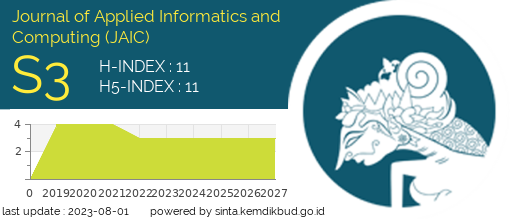Analisis Koefisien Cepstral Emosi Berdasarkan Suara
Abstract
Abstract - The speech signal carries some sort of information, which consists of the intent to be conveyed, who speaks the information, and the emotional information that shows the emotional state of the utterance. One of the characteristics of human voice is the fundamental frequency. In this study the selection of features and methods of classification and recognition is important to recognize the emotional level (anger, sadness, fear, pleasure and neutral) contained in the dataset, this research proposes design through two main processes of training and introduction recognition). Experiments conducted using the Indonesian emotion voice dataset and the Mel-Frequency Cepstrum Coefficients (MFCC) algorithm were used to extract features from sound emotion. MFCC produces 13 cepstral coefficients of each of the sound emotion signals. This coefficient is used as an input of classification of emotional data from 250 data sampling.
Downloads
References
J. Or, (2008). Affective Computing, Emotion Expression, Synthesis and Recognition. I-Tech Education and Publishing.
C. Busso, S. Lee, and S. Narayanan, (2009).“Analysis of Emotionally Salient Aspects of Fundamental Frequency for Emotion Detection,”IEEE Transactions on Audio, Speech, and Language Processing.
Y. Shi and W. Song, (2010).“Speech emotion recognition based on data mining technology,” in Sixth International Conference on Natural Computation (ICNC), Aug., vol. 2, pp. 615–619.
T. Iliou and C.-N. Anagnostopoulos, (2010).“SVM-MLP-PNN Classifiers on Speech Emotion Recognition Field - A Comparative Study.
I. Luengo, E. Navas, and I. Hernáez, (2010).“Feature Analysis and Evaluation for Automatic Emotion Identification in Speech,”IEEE Transactions on Multimedia, vol. 12, no. 6, pp. 490–501.
J. Cho and S. Kato,(2011).“Detecting emotion from voice using selective Bayesian pairwise classifiers,” in 2011 IEEE Symposium on Computers Informatics (ISCI), pp. 90–95.
S. Casale, A. Russo, G. Scebba, and S. Serrano, (2008).“Speech Emotion Classification Using Machine Learning Algorithms,” in IEEE International Conference on Semantic Computing, pp. 158–165.
J. Wang, Z. Han, and S. Lung, (2011).“Speech emotion recognition system based on genetic algorithm and neural network,” in International Conference on Image Analysis and Signal Processing (IASP), Oct., pp. 578–582.
Muljono, Arifin, (2013). “Emotion Classifications of Indonesian Speech Data Set. 978-1-4673-6278-8/13/$31.00 ©2013IEEE
Plutchik, Robert , (2001). “Nature Of Emotions”. American
Authors who publish with this journal agree to the following terms:
- Authors retain copyright and grant the journal right of first publication with the work simultaneously licensed under a Creative Commons Attribution License (Attribution-ShareAlike 4.0 International (CC BY-SA 4.0) ) that allows others to share the work with an acknowledgement of the work's authorship and initial publication in this journal.
- Authors are able to enter into separate, additional contractual arrangements for the non-exclusive distribution of the journal's published version of the work (e.g., post it to an institutional repository or publish it in a book), with an acknowledgement of its initial publication in this journal.
- Authors are permitted and encouraged to post their work online (e.g., in institutional repositories or on their website) prior to and during the submission process, as it can lead to productive exchanges, as well as earlier and greater citation of published work (See The Effect of Open Access).













